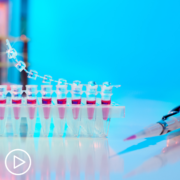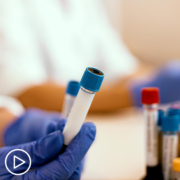See More From INSIST! AML
Related Resources:
Transcript:
Katherine:
Welcome to INSIST! AML. A program focused on empowering patients to insist on better care. Today we’ll discuss the latest advances in AML, including the role of genetic testing and how this may affect treatment options. I’m Katherine Banwell, your host for today’s program. And joining me is Dr. Naval Daver. Welcome, Dr. Daver. Thank you so much for being here. Would you introduce yourself?
Dr. Daver:
Hello. Yeah. Thank you very much, Katherine. It’s a pleasure to join this discussion and meeting. I’m the Associate Professor in the Department of Leukemia at the MD Anderson Cancer Center. I focus on the treatment of acute myeloid leukemia and MDS, including the development of a number of clinical trials that are using targeted therapies and immune therapies for this disease. And with the great and dramatic progress, we’re seeing in acute myeloid leukemia; I think it is now more important than ever for patients to be aware of the options and be able to select the most appropriate therapy with their physicians.
Katherine:
Before we get into the discussion about AML, a reminder that this program is not a substitute for seeking medical advice. Please refer to your own healthcare team. Dr. Daver, I know the field of AML research is advancing rapidly. Would you give us an overview of the current treatment types in AML?
Dr. Daver:
There has been dramatic progress in the treatment of acute myeloid leukemia, especially in the last three years. We’ve had eight new drugs approved for the treatment of acute myeloid leukemia. The most progress I think that has happened so far is in the identification of particular molecular mutations and targeting those mutations with targeted therapies.
The mutations that are most important right now and have target options for FLT3 mutations, F-L-T-3, and the drugs that have been USDA-approved for this are an agent called Midostaurin, which is a first-generation FLT3 inhibitor and combination chemotherapy.
And then, more recently, another agent called Gilteritinib, as a single agent in relapse refractory FLT3 AML. The other mutational group that is also very important, and therapeutically needs to be checked, is IDHN1 and IDH2. And there are now two IDH inhibitors, IDH1 inhibitor, Ivosidenib, and IDH2 inhibitor, Enasidenib, both of which have been approved by the United States FDA for relapse patients with IDH1, IDH2 mutations. So, I think it’s really critical now to check for particular molecular mutations and to appropriately add the particular targeted therapy or select the particular targeted therapy in patients who have the mutation.
The other major area of advancement, and probably, if not the most important breakthrough that has happened, is the development of a new drug called Venetoclax. This is a BCL2 inhibitor. It’s new in AML, but in fact, it has been used for many years in CLL, which is chronic lymphocytic leukemia.
And this drug, in combination with Azacitidine in the frontline setting in older patients with AML who are not good candidates for intensive induction, has shown very high response rates, almost 70 percent CR-CRi, which is more than double of the 20 to 25 percent we were getting with Azacitidine alone.
And it’s now been approved by the US FDA and, in my opinion, and many of the experts really is the new standard of care and should be used in all older patients who are not good candidates for intensive chemotherapy given both the very high response rates, as well as now mature data showing significantly improved overall survival and a good tolerability.
So, there are many other breakthroughs. But I think these targeted agents, and Venetoclax, probably are the most impactful today.
And we’re focusing a number of new combinations building around this.
Katherine:
What are common mutations in AML?
Dr. Daver:
Yeah. So, the most common mutation in AML is F-L-T-3, FLT3 mutation. This is both prognostically important mutation, presence of an FLT3 in a newly diagnosed AML, has been shown in many large publications by the German Cooperative Group, British Cooperative Group, our group, and others, is associated with an inferior survival.
Also, now, on top of that, it is also a therapeutically important mutation in addition to having negative prognostic value because the addition of FLT3 inhibitors seems to dilute, to a large extent, the negative prognostic value.
So, we believe that if we can identify FLT3 mutations at FLT3 inhibitors, we can definitely improve the outcome of those patients. The second most common is what we call NPM1 mutation, and that tends to occur with FLT3. About 55 percent of patients with an FLT3 mutation will have a coopering NPM1.
NPM1 is very interesting. With NPM1 mutation is present on it’s own without a FLT3, it’s actually associated with favorable outcome. It’s a favorable prognostic marker. However, if NPM1 is present with a FLT3, and especially if the FLT3 has a high quantity, high allelic load, then the NPM1 loses its favorable impact. So, now we’re kind of moving beyond just; do you have one mutation or not, which is what we thought 10 years ago, to; well, yes, you have this mutation, but what about the core-occurring mutation and even beyond. What about the burden, or what we call the variant allele frequency of that mutation?
So, for good or bad and I think it’s good in the end because it’s going to improve the patient outcomes, that we are getting more, more in-depth and there’s no longer quote, unquote, AML.
So, there’s a lot more granularity and analysis that is required even before starting treatment. And this is the thing that, in the community, we’re educating the doctors a lot, is that it’s okay to wait four to six days, especially if the patient does not have a very proliferative leukemia, to get the important bloodwork to identify the appropriate molecular and chromosome group.
So, that we can select the right treatment which will improve outcome rather than just rushing into standard treatment and missing a particular molecular chromosome group.
Katherine:
True. It might not be – the genetic testing might not be right for everyone.
Dr. Daver:
Right. Right.
Katherine:
What is genetic testing in AML?
Dr. Daver:
So, genetic testing in AML is basically what we call molecular profiling.
So, it’s looking at the presence of particular molecular mutations. For example, at MD Anderson, we do what we call 81 gene panel. So, this looks at 81 different genes for mutations in the bone marrow of newly diagnosed acute myeloid leukemia. Now, how did we come up with 81 genes? So, this was actually done by literature analysis and review of previously published preclinical and translational studies, and we basically selected all mutations that had been shown to occur in two percent or more of thousands of AML patients. And we found 81 such mutations. So, that any mutation that had a two percent or higher frequency in known published or public databases was included.
And that’s how we’re able to analyze for the mutation. So, it’s still possible that there may be some very rare mutations that are present, and those may be important for research. But they don’t change our treatment decision today. And so that’s what we call genetic profiling. Some people call it molecular mutation analysis. Some people call it next-generation sequencing.
But basically, this is looking for mutations in particular genes that are known to occur in AML. Now of those 81 genes; and some people do a 100 gene panel, some do 50, so those are variables; but among those, there are four or five that are most important: the FLT3, as we discussed, where we can use FLT3 inhibitors; IDH1 and two, because we can use IDH1 and IDH2 inhibitors; TP53 is a very important mutation because it has very high risk and adverse prognosis.
And there are now new drugs coming that may be very effective in TP53. So, we are checking for that. Those drugs are in trials, but the trials are showing very promising data and could be a great option if a patient is known to have a TP53.
Those drugs are Magrolimab, CD47 antibody, and APR-246. So, these are the four most important therapeutic mutations.
There are also some mutations that have prognostic value even though we cannot target them. These include mutations like RUNX1, DNMP3A, ASXL1.
One does not need to know the list. But the point is that these mutations may help determine whether a patient falls into intermediate-risk group or high-risk group, which then impacts the decision as to whether we need a stem cell transplant or not. So, it really is important to get this molecular profiling. It’s actually available in the United States commercially. And any clinic or hospital is able to actually order it. And insurance will cover it in 100 percent of the cases.
Katherine:
Wow, that’s great. What should – when should patients be tested, and how is testing done?
Dr. Daver:
Yeah. So, the basic testing for any suspected new acute leukemia is to get a bone marrow biopsy. That has to be done.
That should be done very quickly because all of the information that will be generated to make the treatment decision will come off the bone marrow biopsy.
Katherine:
What about retesting, Dr. Daver? Is that necessary?
Dr. Daver:
Yeah. So, retesting is necessary in – not for everything, I think.
But let’s say someone had treatment induction and relapsed a year later. So, we would definitely retest: 1) to confirm with the bone marrow’s relapsed AML, get the blast percentage because we need that before restarting treatment, so we know what was the starting point to know how the patients doing after treatment if he’s responding. 2) Molecular testing, for sure, should be repeated. We usually repeat the molecular testing such as FLT3, IDH1, IDH2, because there are drugs that can target these mutations in a relapse.
And more interestingly, we actually have published, and other groups have also published, that there are some patients who may not have those mutations at baseline but may actually acquire or have detectible mutations at relapse. So, if you don’t have FLT3 at baseline, your physician may assume that the FLT3 is not there, not do mutational testing. But in fact, that may not be true. So, it is important to retest about 15 percent, one five percent, in our publications can acquire a detectible FLT3. Which is critical because this could then change your treatment.
IDH1 and two are rarely lost or acquired, but we have seen a few five percent or so cases of that. So, it’s still better to check for that. And then TP53 we check for because now we have these new research clinical trials, phase one, two, that are showing some very encouraging activity in TP53. So, these are probably the main things to retest for.
There’s also some new clinical data emerging with a new drug called menin inhibitor that targets a particular chromosome abnormality, MLL rearrangement. This is again in a phase one setting, so the data may not be widely disseminated. But we’re seeing some very encouraging activity with menin inhibitors.
And so, we are 100 percent checking for the MLL rearrangement chromosome, which can be done on FISH, or routine chromosome.
And if that is there then trying to get on one of the menin inhibitor trials, they’re opening about 25, 30 centers with different menin inhibitors, would be a very, very good option because we think these will be the next molecular or chromosome-targeted breakthrough in AML.
Katherine:
We’ve been discussing how molecular testing results lead to targeted therapy. How do targeted therapies work?
Dr. Daver:
Targeted therapy means that we’re targeting a particular mutation. Now we may be targeting in different ways. So, some of the drugs, like FLT3 inhibitors, these are the most established and oldest targeted therapies in acute myeloid leukemia, been in development for about 18 to 20 years, work by blocking a particular receptor, the FLT3 receptor.
That receptor, when blocked, removes the growth and proliferation signal to the leukemia blast. And that receptor is much more preferentially and heavily expressed on the surface of the acute myeloid leukemia cell as compared to the normal, healthy myeloid or lymphoid cell. So, basically, we are shutting down the growth signals, resulting in eventual death of the leukemia blast and that’s how FLT3 inhibitors work. So, it’s a more of a direct activity resulting in cell death over a few days and quick action. On the other hand, we have what also is called targeted therapies but act very differently. These are IDH1, IDH2 inhibitors.
So, when you use an IDH1 or two inhibitor, they do go to the IDH1 and two receptor on the surface of the acute myeloid leukemia cell, but actually, they don’t result in the death of the cell. They actually cause what we call differentiation.
So, they promote that immature abnormal leukemia cell to undergo maturation and become a normal myeloid cell, which, over time, will die because normal cells have a finite lifespan, and they will die. As compared to leukemia blasts, which can live on much, much, much longer. And so, this process is called differentiation. So, FLT3 inhibitor, very different direct cell death. IDH inhibitor, very different from most maturation differentiation of immature cells to mature cells and takes longer. So, this is important clinically because with FLT3 inhibitors. We see responses quickly, one to two months. IDH inhibitors it takes longer, three to five months.
And so, targeted therapy is not one and all the same. You may be targeting a particular receptor, but the modality of action downstream may be very different.
Katherine:
What’s the treatment regimen for targeted therapies, and how long are patients treated with these types of therapies?
Dr. Daver:
Yeah. I mean, that’s an area of big research. There’s no one field of answer yet for – and I don’t think there will be.
Of course, eventually. So, it really depends on; 1) What setting we’re using it in? Newly diagnosed, relapsed AML. In relapsed AML, with most targeted therapies, whether you’re use is a single agent, like FLT3, IDH1, IDH2, TP53, MLL-targeted agents, the goal is to get a patient to transplant.
Transplant, meaning allogeneic stem cell transplant using a sibling donor or a match-generated donor.
Because in relapsed AML without transplant, irrespective of the genetics and chromosomes, all relapsed AML have very poor outcome. The survival is only 20 percent or less without transplant.
If we can get a patient to transplant, we do have a good chance of long-term survival. So, the goal is transplant. And we usually use a targeted therapy for short, finite period, two to four months, to get a remission, get to transplant, hope that will cure the disease.
In front line, it’s quite different. We’re using induction chemotherapy with FLT3 inhibitors. In some research trials, we’re adding IDH1 and two inhibitors. We’re using Venetoclax, which is a kind of a targeted therapy.
Also, the BCL2 in combination with hypomethylating agents. And here, the targeted therapy is often used indefinitely. At least for one or two years. But in our approach and our guidelines, we continue the FLT3 inhibitor, IDH1 or two inhibitor or Venetoclax, as long as patient is tolerating it and does not have disease progression.
So, these are being used kind of similar to CML, chronic myeloid leukemia, where we use tyrosine kinase inhibitors or myelofibrosis, where you use jak inhibitors. They don’t cure the disease, but they continue to control the disease as long as you take them.
And in the end, we call this functional cure.
If somebody takes a FLT3 inhibitor and lives 20-plus years, semantically, he was never a cure, like an infection gets cured. But functionally, to me, he lived a normal life, and he was cured.
Dr. Daver:
And so, that’s how we’re using those inhibitors in the frontline setting different from the relapse setting.
Katherine:
How do these newer therapies differ from more traditional chemotherapy?
Dr. Daver:
Yeah. Dramatically different. Completely different from traditional chemotherapy. So, to put it in more layman terms, traditional chemotherapy is like a nuclear bomb. Right? You – There’s a lot of things there in the marrow. You don’t know what’s good. You don’t know what’s bad. Blow it all up and hope that, when the new plants grow, the good ones grow and the bad ones were kill. And, in fact, this is true, to a large extent. Traditional chemotherapy, not to put it down, is actually been curative in a large population of AML for the last three decades. Our group and British MRC and Polish, and many groups have published up to 50 to 65 percent cure rates, especially in younger patients, below 65, with traditional chemotherapy.
So, this is not bad. People always get depressed with leukemia. But if you look at solid tumors, I mean, they have never achieved cure rates above 10 to 15 percent till the last decade or so. So, we were still getting 60, 65 percent cure rate. Two out of three.
So, traditional chemotherapy has done great work. But it was that approach. Just nuclear explosion. Take it all out, and hope good stuff comes.
Now the targeted therapy’s like a sniper. It’s actually looking for the particular leukemia cells and trying to take them out one by one with minimum collateral damage to your healthy bone marrow cells, which are important to produce red cells, platelets, white cells. So, guess what? There’s much less toxicity. You don’t see the hair loss with these agents. You don’t see the mouth sores and mucositis. GI complications are much less; infection risk is usually less.
Not to say they don’t have their own side effects. Unfortunately, even the targeted therapies have unique side effects. But, in general, those side effects are much less impactful in a negative quality-of-life way and much more manageable and tolerable. So – And, in the end of the day, they’re actually often more effective.
So, for example, with the FLT3 inhibitor, the study that was done with Gilterinib and Quizartinib, two very potent FLT3 inhibitors, was looking at a single-agent FLT3 inhibitor versus three-drug, high-intensity combination nuclear chemotherapy. And if I told this to any layperson, they would say, oh my God, that’s completely unfair comparison. You’re going to use three drugs, IV chemo, strong chemo, and compare it to one oral targeted pill. There’s no way the pill can be even equal, leave apart, win.
But guess what? The targeted therapy actually won. It not only was equal. It doubled the response rates, it reduced the toxicities and early mortality and led to improved overall survival, the gold standard. So, this shows that even though they are sniper, they can actually be much more effective with less toxicity. So, it’s a win-win. Better, tolerable, and more effective. Now the next stage within then decade, we think, it’s not one or the either, it’s really a combination. So, we’re reducing the dose of chemotherapy. So, we’re not making it as nuclear as it was. It’s still intense. But much more tolerable. And we’re compensating for that by adding the targeted therapy.
And, in fact, in the end, we expect much higher responses and survival with much better tolerability and lower early mortality. But I don’t think we’re at a stage where traditional chemotherapy is gone. Maybe 10, 12 years from now, as many more developments come, we’ll get there. But I think it still has a role, especially in the younger AML patients.
Katherine:
Dr. Daver, you mentioned the – some common side effects of chemotherapy. What about some of the newer therapies? Do they also have side effects?
Dr. Daver:
Yeah. Absolutely. I mean, every therapy we have in leukemia has a side effect. There’s no drug I can mention that is just devoid of them. Of course, some are less, and some are more. So, to be more specific, I think, for example, IDH1, IDH2 inhibitors, these are probably one of the most tolerable treatments we have in all of leukemia treatment. In general, they don’t cause much myelosuppression. Meaning, drop in blood counts. They don’t cause hair loss. They don’t cause mouth sores and GI upset in majority of people.
They’re always some patients who may. But what they can cause are two things: Number one, is they can cause what we call the differentiation syndrome.
And differentiation syndrome means the blasts that are going from the immature state to the mature state; in that process, they can cause an inflammatory reaction. And this can manifest with fever and cough, and chest pain, hypoxia. It’s something that’s actually very, very easily treatable, giving steroids for three or four days will take care of it. But many times, people were not aware of this. And so, often, we saw this was missed in the community.
So, that’s one specific example. With the FLT3 inhibitors, sometimes we see that they can cause more prolonged drop in blood counts, and count recovery can be delayed. Or we can sometimes see that they may cause some cardiac signals; increase in cardiac intervals. Again, something that, with close monitoring, bloodwork, keeping the electrolytes normal, can be managed. But I don’t want to go through the whole list. But the point is that there are specific and unique side effects that can be seen with particular targeted therapies.
And again, this is a learning curve where we have done these trials for eight to 10 years. So, we became familiar. But when the drug is approved, it’s a – it’s kind of a night-and-day situation in the community. They didn’t have the drug yesterday. They have it today. But there may not be any learning curve there. So, I think that’s where a lot of education and interaction with our colleagues is now coming into play.
But also, patients, I think, need to take this a little bit into their own hands, and also read about the label, read about the drug. So that, if they have side effects, if they actually ask their doctor and say, do you think this could be differentiation? I read about it. Yeah, most people will at least think about it. And I think this could be helpful to make sure that things are not missed. So, we do want patients to be more interactive and kind of take things into their own hand. Because there are so many new drugs out there that their doctors may not be fully familiar yet.
Katherine:
Well, let’s talk about patient advocacy. What are some of the key tests that patients should ask for after they’ve been diagnosed?
Dr. Daver:
Yeah. Absolutely. So, I think the key things that patients should want to get the information is: 1) Knowing the bone marrow blasts.
I mean, that’s really basic. Just knowing what leukemia it is. What are the blast percentage? 2) Is, I think, chromosome analysis is very critical to get that information and to make sure we’re not missing acute promyelocytic leukemia, or core-binding factor leukemia, which have different treatments and very favorable outcomes, and would never, in general, never require a allogenic transplant. At least in majority of cases.
And 3), which is the one where we still see that it may sometimes not be available or be missed, is molecular testing.
I think it’s very critical to request molecular testing. And among molecular testing, especially FLT3, maybe IDH1 and IDH2, and TP53.
So, I think these are the most important data sets. Cytogenetics, key molecular mutations, bone marrow blasts, and confirmation of the type of leukemia before we embark on any treatment.
Katherine:
How can patients feel confident, do you think, in speaking up, and becoming a partner in their care?
Dr. Daver:
Yeah. I mean, this is always a touchy area because physicians may feel that this is kind of encroaching on their territory or telling them what to do. And this is always a major challenge. I think when you go for the clinic visits, just to have a list of your questions written down and having them prepared and prioritizing them.
I always say, have your top-three questions ready.
We’ll try to do the others. But we’ll do the top three. And I think, when you have a new diagnosis of AML, the top three should be: what is the type of leukemia I have, and what are the bone marrow blasts? Number one. Do we have any chromosome and molecular information? Number two. And number three: Are there any specific treatments for my specific AML based on that chromosome molecular information? Or do we need additional information, and can we wait for that safely? I think these are the three very reasonable questions which, I think again, most leukemia experts will automatically be discussing this.
But, I think, for a patient, I think that’s important information to make sure they get before proceeding. If there’s time, the fourth question will be: Is – Are – Do we have a choice between high intensity, low intensity? And if we do, what are the pros and cons? In some cases, there may be a choice. In some cases, it may very clear that high intensity is the way to go, or low intensity is the way to go. But still, I think it’s often good to discuss that with your physician.
So, these are probably the four things one can bring up reasonably without the physician feeling that this is going to take forever, and I cannot discuss this. And then a lot of the AML treatment happens in-patient. So, there will be a lot of time for additional discussion. I tell my patients that, look, once we get the basics and the treatment decided, which is what we do in clinic, then you’ll be in the hospital most of the time. If it’s induction chemo for four weeks. Even if it’s Venetoclax, often they’re admitted for five to seven days, they will have more time then to discuss with the physician, the nurses, on a daily basis, and get more of the nitty-gritty.
Things like diet, exercise, lifestyle. Can I meet friends? I think you should not try to bring those things up right in the first visit. Because that may dilute the key information. So, I think staggering it, keeping in mind that many physicians are extremely busy, and getting that information in pieces over time, is probably productive for you and for the doctor.
Katherine:
With Covid-19 affecting all our lives right now, what should AML patients be considering at this time?
Dr. Daver:
There’s a lot of guidelines on general approaches to managing things in COVID. And all of those guidelines heavily center, as we would think intuitively, on precautions.
Hand washing, minimizing contact, avoiding crowded places, trying to get treatment, potentially locally, if there are equivalent options available. We have not changed any of our frontline – we discuss this a lot every week in our faculty meeting.
This is discussed especially, as you know, because Houston currently is a major center affected heavily by COVID, and so, we have discussed whether we should move in a universal way to lower-intensity therapy for all patients. And we haven’t. And there’s pros and cons to that. When we do induction chemotherapy higher intensity, we, in fact, admit our patients for 28 days.
o, actually, even though it’s high intensity, the patient is more protected because they are in the room. Isolation rooms, sometimes. And they have minimum contact with outsiders. So, with COVID, actually, there’s very little opportunities or chances for them to get it. But the chemo is intensive. So, if they did get COVID, then it could be much more difficult or risky, or even fatal. On the other hand, low-intensity therapy is good because it’s low intensity and the risk of COVID, the frequency may or may not be changed; we don’t know. But the intensity we think could be lower because the immune system has not been suppressed.
However, low-intensity therapy very often is given outpatient. And so, then you have the benefit of lower intensity but the risk that you are going to be driving back and forth to the medical center, getting bloodwork, exposed to people in the waiting room, this and that. So, what we decided, after a lot of discussion among a big leukemia expert faculty in our group, was that we will still decide the optimum treatment based on the leukemia chromosome, molecular, age, fitness of the patient like we’ve always done.
And then we just have to try to encourage the patients to do as much precautions as possible. The other thing with the COVID, I think is very important is that, even though you may not be able to travel to your academic institution nearby because it’s harder to travel now, it’s still a good idea to try to get a consultation. We are doing a number of phone or email consultation, either directly with the patient, and even more frequently with their community doctor.
So, I get every day, four or five emails from academic even, and community physicians just saying, I have this patient, new AML, relapsed AML, whatever the case may be, here’s the mutation chromosome information, and I was going to do this. But the patient asked that I run this by one of my top academic colleagues. So, maybe MD Anderson. Some, I’m sure, are talking to Sloan. Some are, I know, are talking to Dana Farber. Cornell, whatever it may be. So, you can always request that. And maybe 100 percent of physicians may or may not do that.
And we’re seeing this collaboration actually. One of the positive things of COVID is we’re seeing these collaborations becoming better and better over time.
Katherine:
Oh, excellent. If a patient does need to go to clinic for a visit, what safety measures are in place?
Dr. Daver:
Yeah. So, there’s a few things we’re doing in clinic is; one is we have staggered our clinics. So, instead of having everybody come at 9:00 or 10:00 a.m., and having 30 people in the waiting room, we really have more time slots.
And we ask people to come three of them at a time in the waiting room. We’re minimizing it three to five patients at most
Of course, there’s a lot of sanitization, dispensation units everywhere, encouraged to use those. The other important thing which, unfortunately, is a double-edged sword, is that we have had to minimize the number of friends, relatives, spouses, that can come with patients.
In fact, the policy at MD Anderson, like most cancer centers, is that nobody is allowed with the patient unless the patient is physically really impaired, as in wheelchair-bound or cannot go to the restroom. Of course, there are exceptions. But generally, I know, and I actually benefit a lot from it too, when patients have their family because the emotional support also helps our medical team to get information across. The patient may be sometimes stressed and forget things. So, what we’re doing more and more is doing phone calls.
So, what I would recommend is, as soon as doctor comes in, say, hey, doctor, can I call my daughter or my wife? I want her to listen to everything. Perfect. I don’t mind. There’s a speaker on. Good.
So, that helps with communication. But those are the big changes we have done from the clinic perspective. Still seems to be working relatively smoothly. We’re still seeing almost about the same number of patients in clinic that we were before COVID. And we have, fortunately, and knock on wood, not seen big numbers of leukemia patients with COVID. And we think the primary reason is because leukemia patients are just very cautious from the beginning. Even before COVID, they knew the risks, and we want them to continue that as much as possible.
Katherine:
Dr. Daver, thank you so much for joining us today.
Dr. Daver:
Thank you very much. Always a pleasure.
Katherine:
And thank you to all of our partners.
To learn more about AML and to access tools to help you become a more proactive patient, visit powerfulpatients.org. I’m Katherine Banwell – Thank you, Dr. Daver.


























